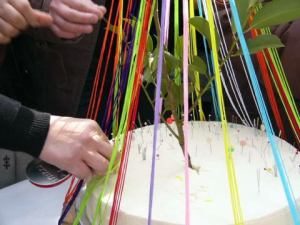NEEDLE Little Help?
Where would we be without needles? The women who crossed the plains in covered wagons treasured their cases filled with .. not gold jewelry .. but fine steel needles. In the territories to which they were going there were no stores and who knew when the next peddler with his pack of necessities would come by. Those precious needles would have to last for months, and maybe even years! Today a pioneer woman would probably think she'd struck gold if she ever tore apart a stitcher's overstuffed recliner!
Traditionally, tapestry needles are used for counted cross stitch and usually found from size 18 (the largest) to size 28 (the smallest). Tapestry needles have a blunt point as opposed to Chenille needles which have a very sharp point (and are idea for waste canvas stitching!). The blunt rounded end of the tapestry needle slips easily into the weave of the fabric without snagging or piercing.
Did you know that the Danish use a larger needle for different counts of fabric than Americans do? It's true. They believe a bigger needle opens the hole wider to allow the plies of floss to flow through with less friction or wear and allows then to loft out so that the strands can lie better side by side. Conversely, they feel that a smaller needle compresses the plies and cause them to become fuzzy by wearing on the floss as it comes through the fabric .. the hole the needle makes is just not big enough for the floss to follow through.
If you have trouble getting your floss to go through the eye of your needle on the first try (or second .. or third), perhaps this little tidbit will help:
Roll the needle 180 degrees and try again.
Did you know that needles have a 'right' and 'wrong' side to them? The naked eye may not be able to see a difference, but one side of the eye is rougher than the other. This comes from the fact that needles are punched out of the metal from which they are made (usually steel-plated with nickle, or gold, or platinum). The side FROM which they are punched is smoother than the side THROUGH which they are punched. So, if your floss is trying to pass through the rougher side, it may catch on the edges and begin to spread out instead of gliding smoothly through.
Here are some general guidelines for selecting a particular size of tapestry needle for different counts of fabrics. But remember .. you need to stitch with what is most comfortable for you!
NEEDLE FABRIC
size 28 18ct Aida, 36 - 40ct Linen
size 26 16 - 18ct Aida, 32 - 36ct Linen
size 24 14 - 16ct Aida, 28 - 32ct Linen
size 22, 20 & 18 6 - 11ct Aida
 Remember too, that you'll need to adjust your needle size for the number of floss plies you are using. Use a size 26 needle if you're stitching with one or two ply; a size 24 for 3 or 4 ply, and a 26 for 4 - 6 ply. Again, the key word is: Experiment.
Remember too, that you'll need to adjust your needle size for the number of floss plies you are using. Use a size 26 needle if you're stitching with one or two ply; a size 24 for 3 or 4 ply, and a 26 for 4 - 6 ply. Again, the key word is: Experiment.
Hope This Helps! Happy Stitching!


